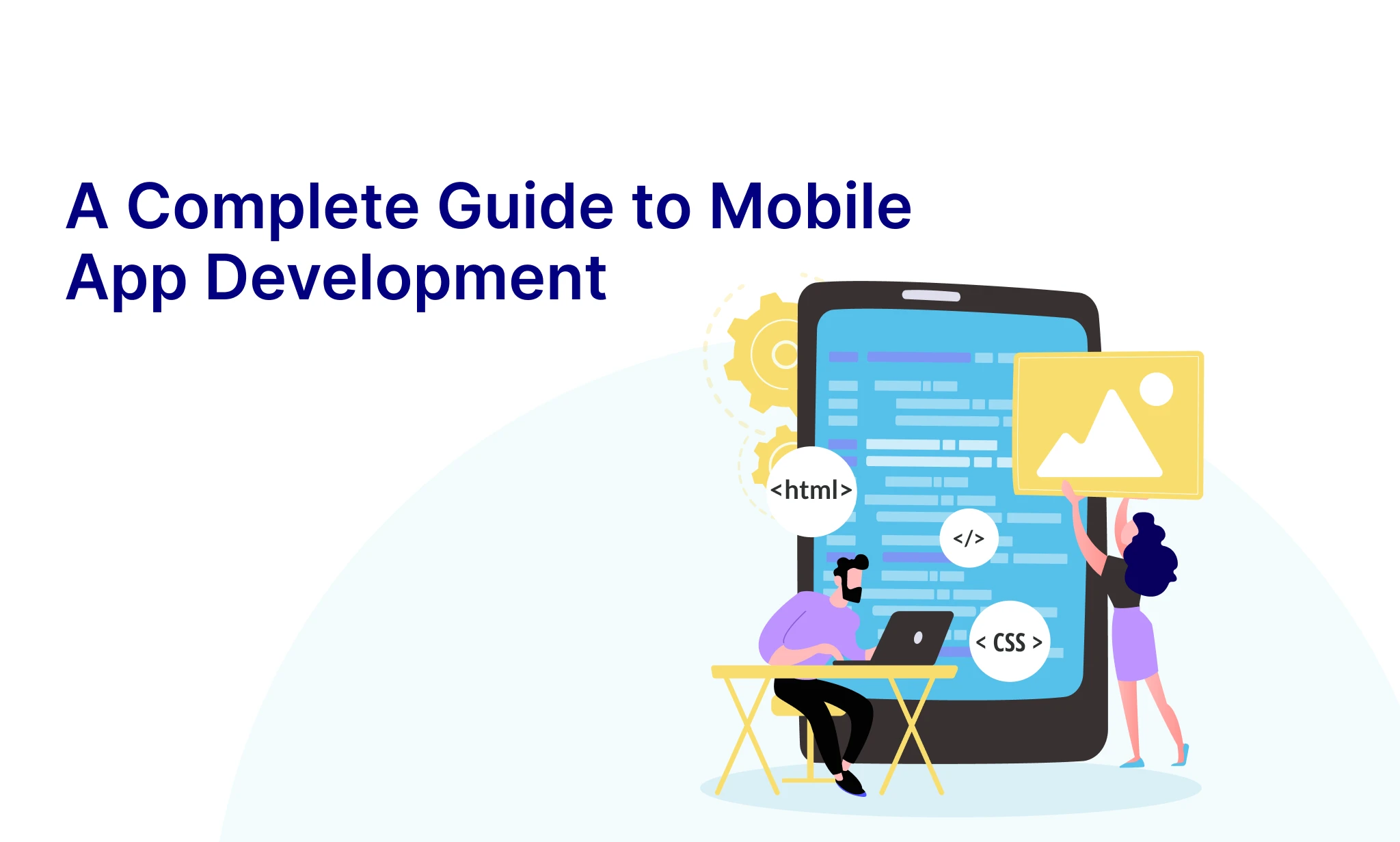Table of Contents
Mobile app development requires prioritizing user experience. Learn how to build mobile apps efficiently and ensure app functionality aligns with the purpose.
With over 4.88 billion smartphone users in 2024 (projected to rise to 6.4 billion by 2029), mobile applications have become an indispensable part of our daily lives.
The mobile application market is anticipated to generate $233 billion by 2026, highlighting the immense opportunities for businesses in mobile app development. While some companies are interested in consumer-facing projects, others want mobile apps to optimize business operations and increase efficiency.
However, having an excellent app idea is merely the first step. Only a few tailored mobile app solutions achieve lasting success in the real world. The difference between a successful and unsuccessful app often hinges on a mix of knowledge, planning, and strategic execution. While knowledge can lead to effective planning, following the correct steps is important to expedite success.
If you want to build a mobile app, here’s a comprehensive guide to the mobile app development process.
Considerations Before Starting the App Development Process
Before diving into the mobile app development process, it’s essential to consider several key factors to ensure your project is successful.
- Strategy definition: Clearly outline the app’s purpose, target audience, and goals to ensure alignment with business objectives.
- Market research: Creating a solid digital presence takes work. Conduct thorough research to understand market needs, competition, and potential gaps your app can fill.
- Budget planning: Allocate a specific budget across various stages of development, including design, development, testing, and marketing.
- User experience design: Focus on creating an intuitive user interface to promote seamless mobile experiences and elevate user engagement and satisfaction.
- Technology selection: Choose the appropriate technology stack that aligns with your app’s requirements and ensures scalability.
- Development team: Assemble a skilled development team that understands your vision and can effectively bring it to life.
- Testing and quality assurance: Plan comprehensive testing to ensure the app is bug-free and performs well under various conditions.
- Launching and marketing: Develop a detailed strategy and marketing plan to promote your app and attract users.
Mobile App Development: 6 Key Steps to Follow
Developing a mobile app requires careful planning and a structural approach to stand out from the competitors. Here’s a step-by-step guide on the key steps to follow:
Step 1: Develop a Strategy
The initial step in mobile app development is defining the strategy, which involves setting goals, understanding capabilities, and outlining the business model. Begin by identifying the main objectives: what problem the app will solve, target users, and desired outcomes. Research competitors to understand the market landscape and find differentiation points.
Platform plays a vital role in providing seamless mobile experiences. So, it is essential to decide on the platform—Android, iOS, or cross-platform—based on the app’s requirements and targeted user base.
Finally, choose a monetization method, such as in-app advertising, purchases, subscriptions, affiliate marketing, or paid apps, aligned with the app’s goals and type. You can opt for a subscription-based app model with premium/exclusive benefits to gauge new users or retain old users.
Step 2: Analysis and Planning
Step two involves analysis and planning. With your idea and initial research in place, focus on defining functional and non-functional requirements, creating a product roadmap, and identifying the necessary technology stack.
Define the actions your app must perform, document these as functional requirements, and consider the system’s performance quality for non-functional requirements. Develop a detailed product roadmap to prioritize features and ensure a successful Minimum Viable Product (MVP).
Finally, focus on the right technology stack. Determine the skills and technologies required, such as experienced iOS developers or cross-platform expertise, before moving on with the mobile app development.
| Discover how Byteridge can revolutionize your digital journey with innovative products tailored for modernisation.<Explore our services> |
Step 3: UI/UX Design
Your app offerings must resonate with your audience. Thus, creating a top-notch user experience is crucial in app design.
A poorly designed mobile app could send users straight to your competitors. This highlights the need for a captivating and easy-to-use UI/UX. Key design components include establishing information architecture, creating workflow diagrams, developing wireframes, and crafting style guides to maintain brand consistency.
Once you have the structure, you can use mockups to translate wireframes into final visuals and ensure design coherence. Prototypes simulate the user journey and help identify and rectify design flaws. Each step demands thoroughness to guarantee a polished and functional end product.
Step 4: App Development
With design wrapped up, let’s dive into the crucial backend and frontend stages of mobile app development.
Backend: This phase involves creating databases and server-side objects, selecting programming languages, and setting up hosting environments. It lays the foundation for your app’s scalability, ensuring it can grow with your user base.
Frontend: This is what users interact with. You have three main options:
- Platform-specific: Tailored for each platform, optimizing performance but possibly at a higher cost.
- Cross-platform: One codebase for multiple platforms, offering cost-effectiveness and code reusability.
- Hybrid: Combines platform-specific and web elements, great for multi-platform functionality when time is limited.
Ensure you work with experienced developers to navigate these stages and build a scalable, user-friendly app.
Step 5: Testing and Deployment
No mobile app is 100% perfect. You need to ensure your app is fully functional and works without bugs. After app development, thorough testing ensures stability and security. Before deployment, your app should undergo five essential testing methods:
- Functionality: Ensure all features work as intended.
- Performance: Test responsiveness and scalability under varying loads.
- Security: Verify adherence to security standards, which is vital for both enterprise and consumer apps.
- Platform and device compatibility: Test on various devices and OS versions to ensure compatibility.
- Extended review: Gather feedback from actual users through focus groups or beta launches.
Once testing is complete, deployment follows specific distribution models. For mainstream platforms like Apple’s App Store or Google’s Play Store, rigorous submission and review processes are required. Private distribution options, like Apple’s Developer Enterprise Program or Android’s Alternative Distributions, offer alternative routes for deployment, each with its considerations.
Step 6: Post-Launch Support
Monitoring app performance closely after it goes live and gains traction is crucial. Key metrics to focus on include app downloads, active users, average visit time, retention, churn, conversions, customer lifetime value, ratings, and reviews. Tracking crashes, bugs, customer requests, and overall app performance is essential to refine your solution over time.
Remember, app development is an ongoing process. Your mobile app needs to be updated with the latest mobile technology trends. Regular updates are essential to adapt to OS changes and maintain functionality. Whether you manage maintenance internally or through a software development partner, continuous support is crucial for long-term success.
Reimagine Your Mobile App Development with Byteridge
Navigating the complexities of mobile app development requires a focus on user experience, whether you’re crafting cross-platform or native applications. It’s essential that your app’s functionality aligns with its primary purpose and that its interactive elements are user-friendly.
The development path you choose hinges on various factors, such as budget, objectives, timeframe, technical proficiency, and the complexity of your app. Byteridge is a leading name in mobile app development.
We aim to develop intuitive and innovative applications tailored to the unique needs of mobile app development. From concept to launch, we provide comprehensive mobile app development solutions, ensuring seamless execution by expert professionals.
| Join us in pushing boundaries and unlocking endless possibilities for industries.<Talk to an Expert> |








